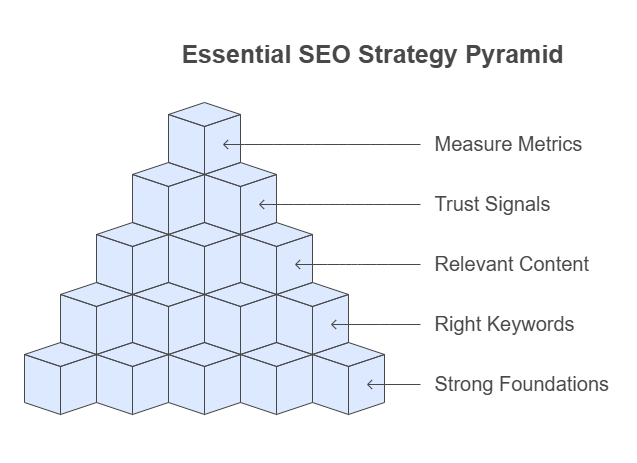Part 5 of a 10 part series: The Small Business Owner’s Guide to SEO in 2025
If you’re putting time (or money) into SEO, you want to know it’s actually doing something.
Not just ranking for random keywords—but bringing in real people, real leads, and real results.
That doesn’t happen by accident.
The small business SEO strategies that work best are simple, strategic, and sustainable. So let’s break down what an effective plan actually looks like- without the fluff, without the jargon, and without overwhelming you.
What a Strong Small Business SEO Strategy Actually Looks Like
A good SEO strategy has one job: connect the right people to your website at the right time.
It’s not about chasing clicks or gaming the algorithm. It’s about helping your ideal customers find you when they’re ready to take action- book, buy, or reach out.
Here’s the basic framework that works (and keeps working over time):
- Start with strong foundations – Clean site structure, fast loading, mobile-friendly design.
- Focus on the right keywords – What your customers are actually searching for.
- Create helpful, relevant content – Blog posts, FAQs, and pages that answer real questions.
- Build trust signals – Backlinks, reviews, and listings that tell Google you’re legit.
- Measure what matters – Track traffic, rankings, and conversions—not just vanity metrics.

🔗 Related reading: If you’re still mapping out your SEO budget, check out The Hidden Costs of SEO: What You Need to Know.
The Balance of On-Page, Off-Page, and Technical SEO
Every SEO strategy should include these three pillars—skip one, and the whole thing feels off balance.
1. On-Page SEO
This is what you control directly on your website- your content, headings, page titles, URLs, and internal links.
What to focus on:
- Clear, keyword-aligned titles and headings
- Easy-to-read formatting (short paragraphs, bullets, subheadings)
- Descriptive meta descriptions that get people to click
- Internal links to keep people moving through your site
2. Off-Page SEO
This is all the stuff that happens outside your site that affects your rankings, especially your credibility and trustworthiness.
What to focus on:
- Getting backlinks from reputable sites
- Building out your Google Business Profile
- Consistent listings across online directories
- Encouraging client reviews on Google and other platforms
3. Technical SEO
This is the behind-the-scenes stuff that helps search engines crawl, understand, and index your site correctly.
What to focus on:
- Fast page load times
- Secure website (HTTPS)
- Mobile responsiveness
- Clean URLs and site structure
- Fixing broken links or crawl errors

🔗 Tools like Google Search Console, Screaming Frog, and Ubersuggest can help you stay on top of all three.
Setting Realistic SEO Goals (and Actually Tracking Them)
SEO takes time, but that doesn’t mean you can’t track progress or set clear goals.
The key is to aim for growth, not perfection.
Examples of realistic SEO goals:
- Increase organic traffic by 20% in 6 months
- Rank in the top 3 for a key service page in your city
- Publish 2 blog posts per month targeting customer questions
- Cut homepage load time to under 2 seconds
- Get 5 new backlinks in the next quarter
How to track your progress:
- Use Google Analytics to monitor traffic and conversions
- Check Google Search Console for keyword visibility
- Keep an eye on page speed with PageSpeed Insights
Remember: SEO results are cumulative. Every tweak, every blog post, every backlink adds up.
Common Mistakes to Avoid
Even the best strategy can fall flat if you’re stuck in one of these traps:
❌ Keyword stuffing
Using your target keyword 47 times doesn’t help, it makes your content unreadable.
❌ Ignoring mobile
More than half of searches happen on mobile. If your site’s hard to use on a phone, you’re losing visitors (and rankings).
❌ Forgetting about user experience
Google pays attention to bounce rate, time on page, and click-through rate. If your content isn’t helpful or easy to navigate, it won’t perform.
❌ Giving up too soon
SEO isn’t instant. Give it time, usually 3–6 months, before you expect to see big shifts. (And even then, they compound.)
🔗 Related: If you’re deciding whether to DIY or get help, don’t miss DIY SEO vs. Hiring an Expert: Which Path Should You Take?
Final Thoughts: Keep It Simple, Keep It Strategic
You don’t need to do everything at once. The best SEO strategy is the one you can stick with consistently.
Start with your core pages. Write a blog post or two. Fix what’s broken. Track your results. Adjust over time. And if it ever feels like too much—you can always get support.
Need help building or refining your SEO strategy?
👉 Here’s how I help small business owners like you build websites that rank and convert.
Coming Up Next in the SEO Cost Series
👉 Budget SEO: How to Get the Most Value for Your Money
We’ll talk about stretching your SEO dollars without cutting corners.
Have questions about your strategy so far? Drop them in the comments—I’d love to hear what you’re working on.
The Small Business Owner’s Guide to SEO in 2025
- Part 1: The Real Value of SEO: Is It Worth the Investment?
- Part 2: Understanding SEO Pricing Models: What’s Right for Your Business?
- Part 3: The Hidden Costs of SEO: What You Need to Know
- Part 4: DIY SEO vs. Hiring an Expert: Which Path Should You Take?
- Part 5: The SEO Strategy That Gets the Best Results for Small Businesses
- Part 6: Budget SEO – How to Get the Most Value for Your Money
- Part 7: SEO Scams and Red Flags: How to Avoid Wasting Your Money
- Part 8: How Long Does SEO Take? A Realistic Timeline for Small Businesses
- Part 9: Local SEO Costs – What You Need to Compete in Your Area
- Part 10: The Future of SEO – What Small Businesses Need to Prepare For





